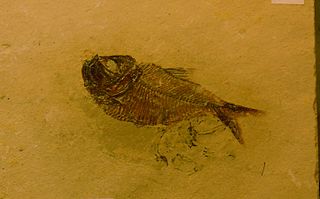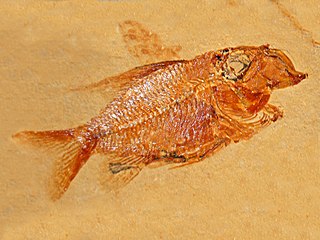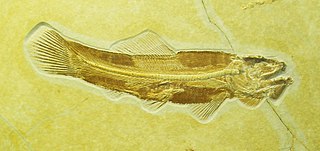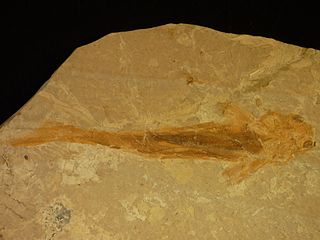| Spathiurus Temporal range: | |
|---|---|
| Scientific classification | |
| Kingdom: | |
| Phylum: | |
| Class: | |
| Order: | |
| Family: | |
| Genus: | †Spathiurus |
| Species: | †S. dorsalis |
| Binomial name | |
| †Spathiurus dorsalis Davis,1887 | |
| Synonyms | |
| |
Spathiurus is an extinct genus of prehistoric ray-finned fish that lived during the Cenomanian in the Sannine Formation of Lebanon. [1]
Spathiurus was designated as a member of the Ionoscopidae family in 2020 as it shows the diagnostic features of the group, making it the first member of the family to be known from the late Cretaceous as well as the Middle East. [2] It is believed to be a sister taxon to Ionoscopus petrarojae, the both are more derived than 'Ionoscopus' cyprinoides, which probably belongs in a different distinct genus. [2] The species Amphilaphurus major is currently believed synonymous with Spathiurus dorsalis. [2]

Protobrama is an extinct genus of teleost fish from the Cretaceous period of Lebanon.
Plectocretacicus is an extinct genus of prehistoric ray-finned fish that lived during the lower Cenomanian. It contains a single species, P. clarae. Plectocretacicus is the earliest known member of the order Tetraodontiformes.

Coccodus is an extinct genus of extinct pycnodontid fish that lived during the lower Cenomanian. The various species had a pair of massive, curved spines emanating from the lower sides of the head, and one curved spine on the top of its head. Unlike most pycnodontids, Coccodus species had a comparatively long body, giving the living animals a superficial resemblance to a scaly chimaera.
Chanopsis is an extinct genus of prehistoric bony fish that lived during the Aptian stage of the Early Cretaceous epoch.

Lissoberyx is an extinct genus of prehistoric ray-finned fish belongon to the family Trachichthyidae. Lissoberyx is a trachichthyid, but it shows more resemblance to the holocentrids than any other trachichthyid.
Macrepistius is an extinct genus of prehistoric ray-finned fish that lived during the Albian stage of the Early Cretaceous epoch.
Flindersichthys is an extinct genus of prehistoric bony fish that lived during the Albian stage of the Early Cretaceous epoch.
Prymnetes is an extinct genus of prehistoric bony fish that lived during the Late Cretaceous epoch.
Polygyrodus is an extinct genus of prehistoric ray-finned fish that lived during the Late Cretaceous epoch. The name is a combination of the Greek words poly (many), gyro (round), and odoy (tooth).
Mesoclupea showchangensis is an extinct ichthyodectiform ray-finned fish that lived in freshwater environments in what is now China during the Early Cretaceous epoch. It differs from its sister genus, Chuhsiungichthys, primarily by having a more posteriorly-placed dorsal fin.
Stichopterus is an extinct genus of chondrostean ray-finned fish that lived during the Early Cretaceous epoch in Asia. It has been found in Russia and Mongolia.
Lualabaea is an extinct genus of prehistoric coelacanth, belonging to the family Mawsoniidae, containing the single species L. lerichei. It has been found in Late Jurassic or Berriasian aged deposits in the Democratic Republic of the Congo.

Amiopsis is an extinct genus of prehistoric bony fish belonging to the family Amiidae. Fossils are known from the Late Jurassic Solnhofen Limestone, Germany, the Early Cretaceous Purbeck Group, England, La Pedrera de Rúbies Formation, Spain and Bernnissant Iguanodon locality, Belgium and the Late Cretaceous (Cenomanian) of the Balkans. The monophyly of the genus is questionable, due to it being based on a single character, "the presence of three or more lateral fossae on each side of most abdominal centra". Remains previously assigned to this genus from the Early Cretaceous Las Hoyas, Spain have been moved into the new genus Hispanamia.
Psilichthys is an extinct genus of prehistoric bony fish from the Lower Cretaceous epoch of what is now Victoria, Australia. It has previously been referred to the family Birgeriidae; however it was removed from this family due to differences with Birgeria.
Egertonia is an extinct genus of prehistoric bony fish. The earliest occurrences of the genus in the fossil record are from the Late Cretaceous of Madagascar and India.
Osmeroides is an extinct genus of prehistoric ray-finned fish from the Cretaceous.
Pleuropholis is an extinct genus of prehistoric ray-finned fish.

Peipiaosteus is an extinct genus of prehistoric chondrostean ray-finned fish. Its fossils are found in the Early Cretaceous Jiufotang Formation, Pani Lake, Liaoning Province, China.
Chuhsiungichthys is an extinct genus of ichthyodectiform ray-finned fish that lived in freshwater environments in what is now Yunnan, China, and Kyushu, Japan, during the Cretaceous. It differs from its sister genus, Mesoclupea, primarily by having a comparatively more anteriorly-placed dorsal fin.

Ophiopsiella is an extinct genus of prehistoric ray-finned fish.
{{cite journal}}: CS1 maint: multiple names: authors list (link)